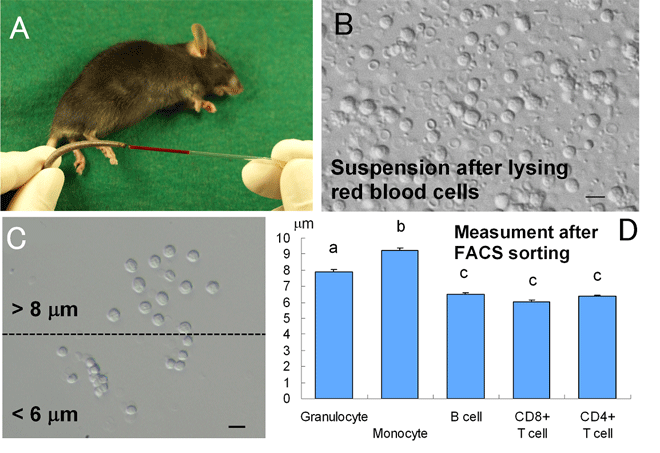 |
BRC Current Technology June 2013 |
7. Mouse cloning using a drop of peripheral blood
For the rescue of infertile founder animals or a “last-of-line” animal
Cloning mice by somatic cell nuclear transfer (SCNT) is a promising technology with potential applications in conservation of invaluable genetic resources. Although many somatic cell types have so far been successfully used for cloning mice, ease of access and noninvasiveness at cell collection and readiness for experimental use should also be key determinants of usable donors for this purpose. In this context, cells collected from a small volume of peripheral blood are expected to fall into this category. We found that 15-45 µl of blood collected from the tail tip was enough for conducting nuclear transfer experiments. (A and B). The key to successful is how to avoid the use of lymphocytes, which inevitably results in the birth of offspring with DNA rearrangements, Sorting by conventional FACS cannot be applied to such a small volume of blood. We found that the size could be a reliable parameter to select non-lymphocytes (monocytes and granulocytes) (C and D). We could select non-lymphocytes at about 85% accuracy, by picking up cells > 8 µm. We applied this granulocyte/monocyte cloning technique to two genetically modified strains and two recombinant inbred strains. Normal-looking offspring were obtained from all four strains tested. The present study clearly indicated that genetic copies of mice could be produced using a drop of peripheral blood from living donors. This strategy will be applied to the rescue of infertile founder animals or a “last-of-line” animal possessing invaluable genetic resources.
(Bioresource Engineering Division, RIKEN BRC)
Reference: Kamimura et al., Biol Reprod doi: 10.1095/biolreprod.113.110098
http://www.biolreprod.org/content/early/2013/06/25/biolreprod.113.110098.abstract





